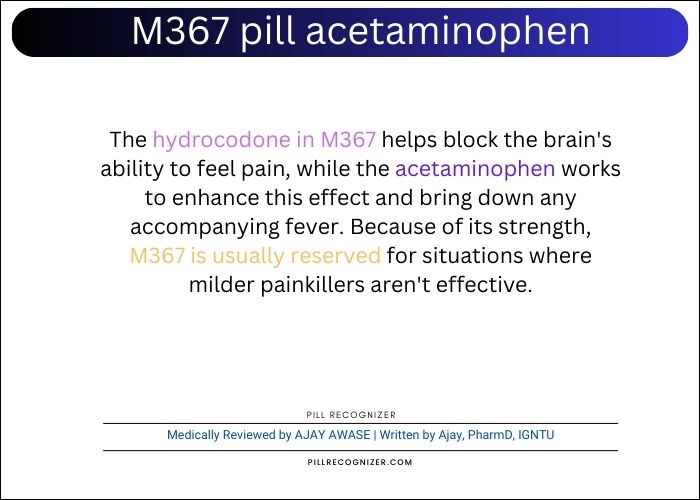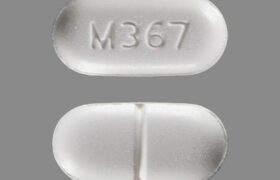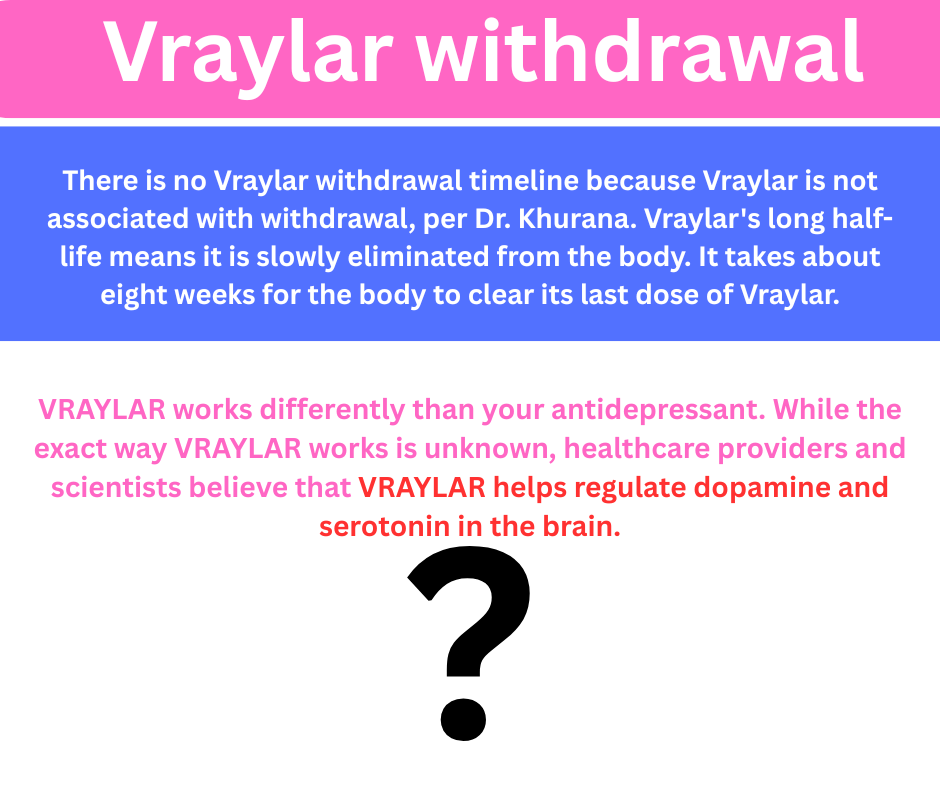M367 Pill – white capsule/oblong, 15mm
Medically Reviewed by AJAY AWASE | Written by Ajay, PharmD, IGNTU
The white, oblong, capsule-shaped pill with the imprint M367 is identified as containing 325 mg of hydrocodone bitartrate and 10 mg of acetaminophen. Mallinckrodt Pharmaceuticals provides it.
Acetaminophen/hydrocodone is a medication that is part of the narcotic analgesic combination class and is used to treat back pain, pain, and cough. Pregnancy cannot be considered risk-free. The Controlled Substance Act (CSA) classifies acetaminophen/hydrocodone 325 mg / 10 mg as a Schedule 2 controlled substance.
Drug Information
| Feature | Value |
|---|---|
| Availability | Rx and/or OTC |
| Drug Class | Miscellaneous analgesics |
| Pregnancy Category | C (Risk cannot be ruled out) |
| CSA Schedule | Not a Controlled Drug |
| Labeler / Supplier | Kroger Company |
| National Drug Code (NDC) | 30142-0484 |
Table of Contents
- How to use Hydrocodone-Acetaminophen
- Side Effects of Hydrocodone-Acetaminophen
- Precautions
- Interactions
- Overdose

How to use Hydrocodone-Acetaminophen
Common uses of hydrocodone-acetaminophen include:
- Postoperative pain: Relieving pain after surgery
- Trauma-related pain: Managing pain associated with injuries or accidents
- Cancer pain: Alleviating pain caused by cancer
Important considerations:
Pregnancy and breastfeeding: If you are pregnant or nursing, talk to your doctor before using hydrocodone-acetaminophen.
Addiction risk: As an opioid, hydrocodone carries the danger of addiction. It is crucial to take it as directed and to stay away from abuse.
Liver damage: Overuse of acetaminophen might harm the liver. Don’t take more than the suggested amount each day.
Before taking this prescription and each time you get a refill, read the prescription Guide and, if available, the Patient Information Leaflet issued by your pharmacist. See your physician or pharmacist if you have any queries.
Administer this drug orally as prescribed by your physician. This medication can be used with or without food. Taking this medication with food may help if you experience nausea. Find out more about additional strategies to reduce nausea from your doctor or pharmacist (e.g., lying down for one to two hours with as little movement of the head as possible).
If you are taking this medication in liquid form, measure the recommended dosage precisely with a pharmaceutical measuring tool. Never use a regular spoon from home because you may not get the correct dose.
Side Effects of Hydrocodone-Acetaminophen
There are numerous potential negative effects of hydrocodone-acetaminophen, some of which could be dangerous. It’s critical to be aware of these possible adverse effects and to let your doctor know about any worrying symptoms.
Common side effects include:
- Constipation
- Nausea and vomiting
- Drowsiness
- Headache
- Dizziness
- Dry mouth
- Sweating
- Constipation
More serious side effects can include:
- Addiction: One opioid that can become addicted to is hydrocodone.
- Overdose: It is possible to die from a hydrocodone-acetaminophen overdose.
- Liver damage: Overuse of acetaminophen might harm the liver.
- Respiratory depression: Breathing can be slowed down by hydrocodone.
- Allergic reactions: Allergy reactions could cause breathing difficulties, edema, or hives.
Precautions
Inform your doctor or pharmacist before using this drug if you have any allergies, including to other opioids like morphine, hydromorphone, benzhydrocodone, or codeine, or to any other medication. Inactive chemicals in this product have the potential to trigger allergic reactions or other issues. For further information, consult your pharmacist.
Inform your doctor or pharmacist about all of your medical history before using this medication, with particular attention to any of the following: brain disorders (such as head injuries, tumors, seizures); breathing issues (such as asthma, sleep apnea, chronic obstructive pulmonary disease-COPD); kidney disease; liver disease; mental/emotional disorders (such as confusion, depression, suicidal thoughts); personal or family history of a substance use disorder (such as drug or alcohol addiction, overuse, constipation.
Interactions
Drug interactions might alter the way your prescriptions function or raise the possibility of severe side effects. Not every potential medication interaction is covered in this document. Make a list of everything you use, including over-the-counter and prescription medications as well as herbal remedies, and provide it to your pharmacist and physician. Before beginning, stopping, or altering the amount of any medication, get your doctor’s approval.
Products like naltrexone, samidorphan, and several painkillers (mixed opioid agonist/antagonists like butorphanol, nalbuphine, and pentazocine) may interact with this medication.
Overdose
If naloxone is available, administer it to someone who has overdosed and is experiencing severe symptoms like fainting out or breathing difficulties before calling 911. Call a poison control center as soon as possible if the person is awake and not exhibiting any symptoms. Residents in the US can dial 1-800-222-1222. Residents of Canada can dial 1-844-764-7669. Overdosage symptoms can include coma, yellowing of the eyes and skin, dark urine, nausea, vomiting, loss of appetite, sweating, stomach/abdominal pain, and slow/shallow breathing.

